Pipp
Well-Known Member
[align=left]Feel free to link to this page, but please don't repost this article elsewherewithoutpermission, and if permission is granted, please credit the author and the site.Thank you. [/align]
[align=left]also see: Bonding Bunnies [/align]
[align=left]
Bonding with your bunny.[/align]
[align=left]by Tracy Hutchings, Feb 2008 (RabbitsOnline.Net)
When we get a new rabbit we instantly want to be its friend, to feel bonded to each other, however, due to the nature of rabbits this is rarely the case. Rabbits are prey animals so generally lack trust, this trust can be won over though, but it can take time. It can run from days into weeks and into months, so donât get disheartened, keep trying and be patient. Many factors can influence how long it takes you to become your bunnyâs friend; some are very obvious such as the rabbitâs past experiences (a rabbit that has experienced abuse at the hands of a human might take longer to trust people), or his/her nature (an anxious, shy or cautious rabbit might take longer to trust), or it can be less obvious things like certain smells, actions, or other things that may cause the rabbit to view you in a cautious manner.
Thereâs a very common misconception that rabbits like to be snuggled and cuddled. It is true that some rabbits do in fact like this, but some rabbits do not. Rabbits have a different way of communicating from people, so your rabbit may be bonded to you, but because you may not know how rabbits communicate and show affection, you might be missing what the rabbit is telling you. So, as well as bonding with your rabbit, it is also important to know what to look for in a rabbit who is showing affection.
Some rabbits can bond with people, be this any person or a specific person, very easily and quickly; that might be due to the nature of the rabbit, or past experiences. If this is the case you are very lucky and may well have found your heart bunny.
Other rabbits take more work and time to win them over and it is up to us to put the work in and win their trust. This can take weeks, months or even longer, but the more you persevere, the more rewarding it will be when your rabbit is tightly bonded to you. There is no definite way to do this because each rabbit and owner is different from everyone else; however, there are certain strategies that owners can use to win over their bunny.
It can take slightly different ways and means to win over indoor rabbits and outdoor rabbits, mainly due to the differences in which they live, and where they live.
When getting a new rabbit, or needing to re-bond with a rabbit, it is important not to expect too much from the rabbit, and to go at the bunnyâs pace, reading the signals that are being given to you. As Sharon (Pet Website, Unknown) says, âTime and patience are the two most important keys to bonding with your new pet bunnyâ, and this is very important to remember this throughout the whole process.
The End Result
[/b]
It seems strange to look at the end result of bonding before it has really begun, however it is important for anyone bonding with a rabbit, to understand rabbits as a whole.
Rabbits are, by design, not cuddly creatures, they are prey animals who find it hard to trust. Due to this, you should not be aiming for a rabbit who snuggles with you, more for a rabbit who feels comfortable and safe with you.
You might find that you have a rabbit who enjoys snuggles, or a rabbit that follows you around but doesnât want to be touched, or a rabbit who loves to be stroked but hates to be picked up. All those examples show a rabbit who is bonded to you, but that has likes and dislikes (such as liking your company, but not liking to be touched, or liking strokes but dislikes being picked up). This is where it is important to learn about affection from rabbits, so that you can read the signals they give you.
Even though you may have an idea of what you want the end outcome to be with your bun, you must be aware that it might not be your rabbitâs ideal outcome, and if you do persevere to get your outcome, it might take a very long time as you might be going against the rabbitâs nature. It would almost be like you eating the foods you like, but avoiding some, and someone wanting you to eat foods you dislike, and then forcing you to eat them until you either tolerated them, or somehow ended up liking them.
Your Mood
[/b]
It is very important to make sure that you are in a calm mood when you are near the rabbit/s, especially when s/he is getting to know you. Rabbits are very sensitive, so pick up on your mood easily. If you are frustrated with the rabbit (or even frustrated in general) s/he will pick that up and be less likely to be friendly; if you are upset by not being the bunnyâs friend, again, s/he will pick this up and might cower from you. Before approaching the rabbit, take some calm, deep breathes and calm yourself down, making your mood neutral (i.e. not any extreme moods). It can also help to remind yourself at this point that your rabbit friend is not being awkward specifically because of you, and that it is not a personal thing; it is the rabbitâs past and character that are influencing how s/he acts.
When your Rabbit Arrives at your home
[/b]
When your rabbit arrives at your house, s/he will have gone through a big upheaval. Depending on the circumstances, this will be more stressful for some rabbits than others. Things to take into account as to the level of stress s/he might be under when s/he arrived are the rabbitâs age, how far s/he has travelled, where s/he has come from (i.e. a rabbit coming straight from a breeder to your home may be under less stress than a rabbit that has gone from a breeder to a pet shop to your home. Also, a rabbit coming from a shelter might be more stressed), what conditions did the rabbit travel in (things like weather, did the rabbit travel with another rabbit).
It has been suggested that that it is important to give your rabbit time to settle in and start to feel at home and safe before starting to bond (Unknown, unknown). Rabbits need to become accustomed to their area, and if they associate your presence with stress, this can have a negative effect on your bonding.
Bonded Pairs[/b]
If you have gained bunnies that are already bonded to another rabbit you might find that the rabbits have less need to bond to you, and so the process can take longer, or you might find that one of the pair bonds quickly to you, but the other doesnât.
Bonded pairs might feel more confident investigating and feel safer in a new environment because they will be together. If one bonds to you, then the other might be more inclined to as well, because s/he will sense what his/her partner feels about you and how his/her partner feels around you. Having said that, if one rabbit associates you with stress, that mood can also be passed onto the other rabbit, so it is very important to watch the body language of the rabbits and to learn what it is they are telling you from their actions.
Things you can try
[/b]
As I have already mentioned it is important that you donât go too fast, and donât push the rabbit more than necessary because this could backfire and make the rabbit retreat back into him/herself. Once the bunny is settled there are lots of things you can try to bond with your bunny; these are by no means exclusive, nor should be seen as that way. There are many methods to try, and these can obviously be used in conjunction with each other to reach the best effect and outcome.
Watching your rabbit[/i]- When you want to bond with your rabbit, you need to learn about your rabbit. An ideal way to do this is to just sit and watch your rabbit/s and not interacting. You can watch his/her habits, how s/he acts to certain things (such as you, anyone else in the house, other animals, noises, toys, smells), his/her favourite places, and quite simply, everything about your rabbit.
This is important because it will help you to read the signals that your rabbit will give you during the bonding process. It will also help you to appeal to your bunny, using the knowledge you have of him/her with regards to toys, favourite foods, safe places, noises s/he does or doesnât like and anything that shows preference.
The additional bonus of sitting and watching your rabbit, is that your rabbit will get used to your presence, which will give bonding a boost.
Talking to your Rabbit[/i]- It can be very helpful to get the rabbit used to your voice without adding pressure to the rabbit. Smith (Unknown) says that âTalking to your rabbit has a calming effectâ. If your rabbit feels calmer, s/he is more likely to trust you and feel calm and safe in your presence.
Sometimes sitting next to the rabbit, whilst the rabbit is in his/her cage, and talking to him/her about mundane things, or reading, might help the rabbit learn that your voice causes no harm, which can in turn lead the rabbit to know that your voice is safe.
Treats[/i]- Treats can be a very good way to entice a rabbit to you, and to teach the bun that being with you has a pleasurable outcome. This can only be used if the rabbit is old enough to tolerate treats, and also if you know what treats your new bunny friend likes (although trial and error can work well if you happen to hit the right treat early on).
There are lots of ways to help your rabbit associate you with treats. Nervous rabbits may take more time to associate you with them, than other bunnies.
To take the process slowly the treat could be placed in the food bowl. This is a place that the rabbit hopefully sees as safe, and so should eat the treat and discover all the deliciousness it holds. Over time the treat can start to be placed elsewhere in the cage so that the rabbit gets used to you putting your hand in and putting down a treat, and then leaving.
At this point the rabbit should start to associate you with the treat, and so you could try placing a treat on your hand and allowing the rabbit to come and take it. Do not move your hand though as this could be seen as threatening behaviour and might take you back a step. If the rabbit does not come and you need to move, place the treat where you hand was, and move (Caroline, Unknown).
A different method might be to, after having placed the treat in various places in the cage, use a fork or spoon to hold it in the cage, but make sure it is held still or it might scare the rabbit.
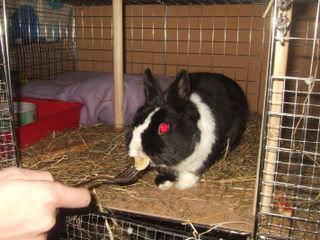 [/align]
[/align]
[align=left]If the rabbit happily takes it from the spoon or fork, you can, over days, weeks, months, move your hand further down the fork or spoon until your hand touches the treat and the rabbit happily takes it.
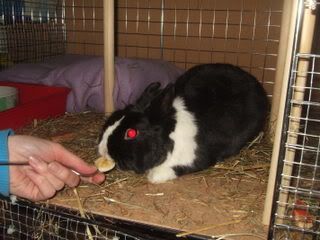
At this point you could try not using the fork or spoon and the rabbit should happily take the treat from your hand.
 [/align]
[/align]
[align=left]Your rabbit now associates you with good things, so good progress is being made. You could then try holding the treat a little way out of the cage, but so the rabbit can get to it and come to you easily, or leave a little trail of treats leading up to you.
Caroline (Unknown) suggest having treats on your lap. Once the rabbit associates you with treats, s/he might be more inclined to sit on your and eat, which is a huge step, as rabbits only eat if they feel safe. This could take some work though, so be patient. The rabbit might be curious, but might take a while to approach the food.


 [/align]
[/align]
[align=left]Ignoring your rabbit[/i][/i]- By this, I do not mean ignore and neglect the rabbit, it has a totally different meaning.
Rabbits are, by nature, very curious animals, and are most likely to investigate and give in to their curiosity if they do not feel threatened.
When your rabbit is out and about and having run time, you can sit or lie in the area. Do not interact with the rabbit, ie. âignoreâ the rabbit.
It can be helpful to do something else, like read, watch the TV, do puzzles, or pretend to do them as you watch the rabbit out the corner of your eye.
Most likely the rabbit will, at first, be confused, but the more you do this around your rabbit, the more curious the rabbit will get. You might find your rabbit sits directly in between you and whatever you are doing (such as between you and your book, if you are reading), or s/he might climb over you as if you are worldâs best toy.
Rabbits can react differently to different positions that you might try. Sitting and lying can encourage different behaviour from the rabbits.
Sitting.

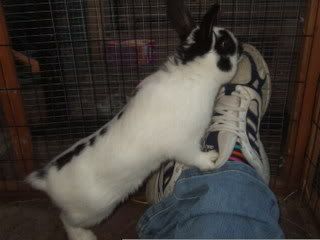 [/align]
[/align]
[align=left]Lying Down.
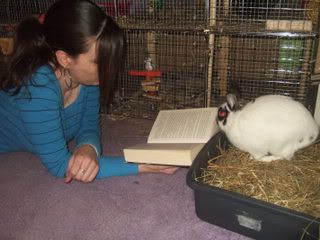
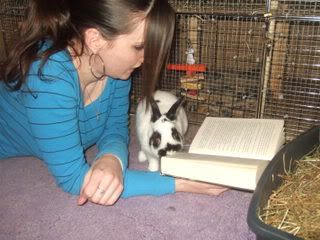
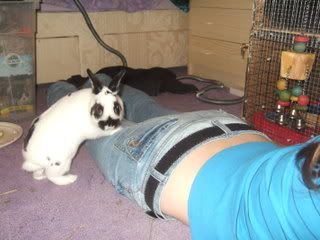
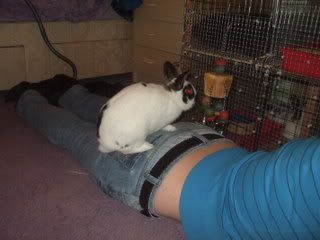 [/align]
[/align]
[align=left]Rabbits can also respond well to positions they donât associate as ânormalâ and might also become curious if you stay in a strange position.
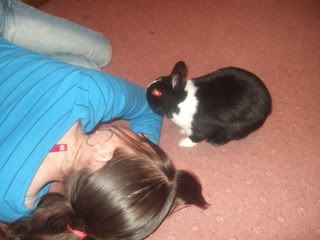

 [/align]
[/align]
[align=left]Any behaviour like this means that your rabbit is learning to trust you and to interact with you, as well as learning to feel safe around you. Itâs important to not move when this is happening because your bun might see this as a threat, and you might end up going backwards through the process.
Combining Methods for Bonding
[/b]
The methods previously mentioned are not exclusive to each other. They can work exceptionally well with each other and combining them can add the extra strength to help bond with your bunny. The reason they are described separately is because each rabbit is different and only the owner can know what things might combine to work best for his/her rabbits.
This is where it becomes trial and error as to what you feel works best for your rabbits. For example, if you are lying on the floor and ignoring your rabbit, you could have treats hidden about your person, and also talk to the rabbit in a soft manner, which combines three of the ideas that have been suggested.
Other Things to be Aware of
[/b]
Control[/i]- It can be helpful for the rabbit to be in control. If it is possible with the rabbitâs housing and setup, allow the rabbit to come out of the cage/hutch by him/herself. This helps the rabbit to feel safer and more secure (DeGroat 2006). This may take a while before the rabbit plucks up the courage to leave, so be patient and wait for the rabbit to move of his/her own accord.
Sometimes itâs not possible nor practical to allow the rabbit to leave by him/herself, such as if the rabbit is housed outside, or if the rabbit is housed off of the ground, or if the rabbit has some form or disability. In these cases, if you have to remove the rabbit from his/her cage, do so slowly and calmly, talking to the rabbit in a low, calm voice. When you bring the bunny to the area that you want them, make sure you have something that the rabbit will deem safe, such as the rabbitâs litter box, or a hidey hole (cardboard box with sellotape removed can be an easy, cheap way to provide a good place to hide), to enable the rabbit to feel safer. The rabbit will need to be placed somewhere near the safe objects (if not even in the object, if this is appropriate) so that s/he knows where it is and knows where to retreat to if necessary.
Strange behaviour[/i]- Once you and you bunny have bonded, there may be times when s/he does not want to come anywhere near you, or acts differently from normal. If the cause is not illness then there will be another cause for this. Looking for other causes and reasons can help you understand your bunny further and also help you to understand why s/he is acting the way s/he is.
Rabbits have a heightened sense of smell, so you should think about how you smell, have you been near new/different animals, have you been to a new place very recently, have you changed any deodorant/perfume/body spray that you wear, is there any possibility that your scent smells foreign to your bunny for whatever reason?
Another reason why rabbits may act different to you might be your mood or how you feel. If you feel negative and go near your bunny, s/he might not want to come near you because they can sense those emotions; this is why it is important to be calm before going near your rabbit. Having said that, some rabbits can sense some moods and sense when their owner needs some comfort, so at times may become far more bonded to you than at previous times.
Your hands[/i]- Hands can be key when bonding with your rabbits because there are certain things that rabbits donât like, or can easily feel threatened by.
Before approaching your rabbit with your hands, make sure s/he knows that you are there. An easy way to do this is by talking to him/her, or, if your rabbit is deaf, try to come up with a light based method of letting the rabbit know, such as flicking a light on and off, or using a torch.
DeGroat (2006) advises that hands should not be put directly in front of the face. This is because rabbitâs see sideways and their vision at the front is limited. Having a hand there, especially with no warning, can startle the rabbit which can make them scared and more wary of future contact with people. Startling a rabbit can also cause him/her to react in a scared manner which might cause him/her to attack you in an effort to protect themselves.
Hands can be placed where a rabbit can investigate them, or smell them, but shouldnât be moved when s/he is interested in them. When approaching a rabbit with your hands, approach not directly from the front, but slightly to the side, where they can see the best. It is also important not to approach from above, as they may see this as a predator (in the wild a rabbit might associate something approaching from above as a bird of prey or some other prey animal). Approach slowly with no dramatic or sudden movement and offer the rabbit your hands so s/he can sniff them which can help them to see that those scary hands are not as scary as they thought.
Stroking and cuddling[/i]- Some bunnies, no matter how tightly bonded they are to you, will never like to be stroked or cuddled. Thatâs ok, thatâs their personality and choice, and it shouldnât be forced on them.
You might be able to win over your bunny, but equally, you may not. This depends on how you approach it, and also how strongly you rabbit feels about being stroked and/or cuddled.
Each rabbit has different preferences for where they might like to be stroked, so it is hard to say which each rabbit prefers without trying it out. As a general rule though, the top of the nose, cheeks and the ears seem to appeal to the widest range of rabbits (fuzzyrabbit.com). If you can find out what your bunny likes, then s/he might be more likely to sit and enjoy a stroke.
Make sure you never allow your bunny to feel trapped, such as being tightly held, when you are trying to bond. There are some cases when this can not be avoided, such as when medicine might need to be given, but for bonding purposes, it is important your bunny knows it is his/her choice to stay there. As with general bonding, try to make it appealing; treats can reinforce how nice strokes are, or s/he might discover it by him/herself provided you hit the right spot for strokes. Be patient with this, as with anything else bonding related and hopefully time will allow your bun to see that being stroked is an enjoyable occurrence.
Ways rabbit show they are comfortable with you.
[/b]
Given that the ideal aim is for your rabbit to show s/he is comfortable with you, it might be helpful to know what a comfortable rabbit looks like.
Lying down, stretched out, asleep or dozing show the rabbit feels safe and comfortable.



 [/align]
[/align]
[align=left]The âdead bunny flopâ also shows a very comfortable rabbit.


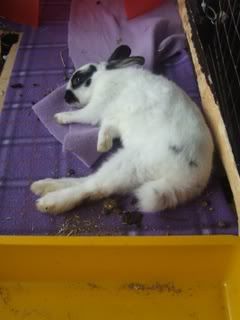 [/align]
[/align]
[align=left]
[/align]
[align=left]Rabbits will only clean themselves if they feel comfortable.


Rabbits will also eat if they feel safe and comfortable.
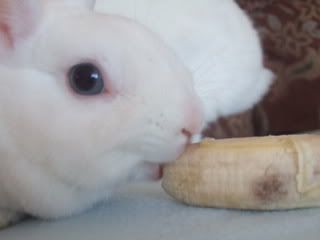
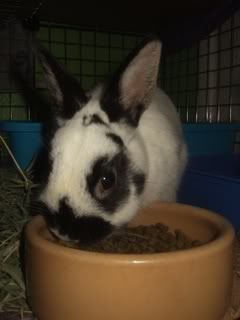 [/align]
[/align]
[align=left]Your rabbit might also start to be more adventurous if s/he feels safe in the surroundings.
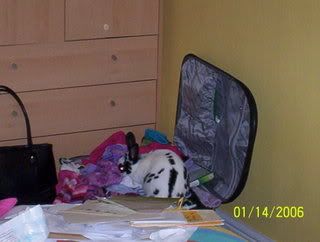
 [/align]
[/align]
[align=left]Indications that a rabbit feels bonded to you[/b]
Rabbits can show in many ways that they feel close to you and bonded to you, and they can be easy to miss as some are very subtle.
Your bunny might come over to see you when you are in the room and s/he is in his/her cage.
 [/align]
[/align]
[align=left]Your rabbit may sit near a part of your body (such as feet, hands) or sit near you generally, but not want contact or a fuss. Your rabbit might also lie down with you.


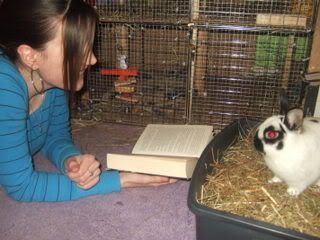 [/align]
[/align]
[align=left]Your bunny might like to follow you around, or walk with you, or be involved in anything that you do. S/he might seek you out and want your company.


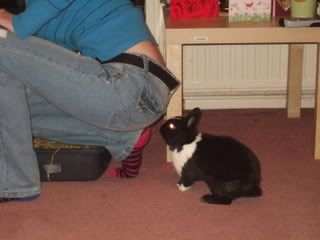 [/align]
[/align]
[align=left]Rabbitâs might also lick or groom you, or your clothing. This shows they love you very much and is a strong indication of a bonded rabbit. A bunny who allows you to stroke them, also feels very safe.
These are only indications of what rabbits who feel bonded to you might do, there are more ways and that comes down to each individual rabbit. If you rabbit does not do all these things, that does not mean they are not bonded, so you need to look at how they act as a whole.
When you are finally bonded with your rabbit, it is such a priceless bond, and can bring happiness to all involved.
Sources
[/b]
Caroline (Unknown). [url]http://www.rabbitresidence.org.uk/bonding.html[/url]
DeGroat, K (2006). [url]http://www.rabbitnetwork.org/articles/shy.shtml[/url]
James, C, 1999. http://web.archive.org/web/20020224075413/www.therabbitcharity.freeserve.co.uk/gestures.html
Fuzzy-Rabbit.com, 2003-2006. http://www.fuzzy-rabbit.com/behaviourfaq.htm
House Rabbit Resource Netowkr, Inc. (2001-2002) http://www.rabbitresource.org/library/behavior/bodylanguage.html
Mercer, E (2001) http://www.paperglyphs.com/rabbits/rabbittalk.html
Sharon (Pet Web Site), Unknown. [url]http://www.petwebsite.com/article_read.asp?id=312&title=Rabbit%20Facts[/url]
Smith, K (Unknown). âRabbit Health in the 21st Century Second Edition: A Guide for Bunny Parentsâ
Unknown, Unknown. http://www.ehow.com/how_16472_bond-with-rabbit.html
Relevant Links[/b]
http://www.adoptarabbit.com/articles/packet/behavior.html
http://www.ddfl.org/behavior/rabbit_behav.pdf
http://www.hopperhome.com/hopperhometalk.htm
RO Threads[/b]
Tips on Bonding with my Bunny
http://www.rabbitsonline.net/view_topic.php?id=28950&forum_id=48
No Connection with Skip
http://www.rabbitsonline.net/view_topic.php?id=28113&forum_id=1
Isis and bonding with me
http://www.rabbitsonline.net/view_topic.php?id=31777&forum_id=48
When She comes around
http://www.rabbitsonline.net/view_topic.php?id=32488&forum_id=1
Handling
http://www.rabbitsonline.net/view_topic.php?id=30245&forum_id=48
How long do I give him?
http://www.rabbitsonline.net/view_topic.php?id=27454&forum_id=48
[/align]
[align=left]written by Tracy Hutchings, Feb 2008, forRabbitsOnline.Net[/align]
[align=left](Please do not reproduce this article without permission)[/align]
[align=left]also see: Bonding Bunnies [/align]
[align=left]
Bonding with your bunny.[/align]
[align=left]by Tracy Hutchings, Feb 2008 (RabbitsOnline.Net)
When we get a new rabbit we instantly want to be its friend, to feel bonded to each other, however, due to the nature of rabbits this is rarely the case. Rabbits are prey animals so generally lack trust, this trust can be won over though, but it can take time. It can run from days into weeks and into months, so donât get disheartened, keep trying and be patient. Many factors can influence how long it takes you to become your bunnyâs friend; some are very obvious such as the rabbitâs past experiences (a rabbit that has experienced abuse at the hands of a human might take longer to trust people), or his/her nature (an anxious, shy or cautious rabbit might take longer to trust), or it can be less obvious things like certain smells, actions, or other things that may cause the rabbit to view you in a cautious manner.
Thereâs a very common misconception that rabbits like to be snuggled and cuddled. It is true that some rabbits do in fact like this, but some rabbits do not. Rabbits have a different way of communicating from people, so your rabbit may be bonded to you, but because you may not know how rabbits communicate and show affection, you might be missing what the rabbit is telling you. So, as well as bonding with your rabbit, it is also important to know what to look for in a rabbit who is showing affection.
Some rabbits can bond with people, be this any person or a specific person, very easily and quickly; that might be due to the nature of the rabbit, or past experiences. If this is the case you are very lucky and may well have found your heart bunny.
Other rabbits take more work and time to win them over and it is up to us to put the work in and win their trust. This can take weeks, months or even longer, but the more you persevere, the more rewarding it will be when your rabbit is tightly bonded to you. There is no definite way to do this because each rabbit and owner is different from everyone else; however, there are certain strategies that owners can use to win over their bunny.
It can take slightly different ways and means to win over indoor rabbits and outdoor rabbits, mainly due to the differences in which they live, and where they live.
When getting a new rabbit, or needing to re-bond with a rabbit, it is important not to expect too much from the rabbit, and to go at the bunnyâs pace, reading the signals that are being given to you. As Sharon (Pet Website, Unknown) says, âTime and patience are the two most important keys to bonding with your new pet bunnyâ, and this is very important to remember this throughout the whole process.
The End Result
[/b]
It seems strange to look at the end result of bonding before it has really begun, however it is important for anyone bonding with a rabbit, to understand rabbits as a whole.
Rabbits are, by design, not cuddly creatures, they are prey animals who find it hard to trust. Due to this, you should not be aiming for a rabbit who snuggles with you, more for a rabbit who feels comfortable and safe with you.
You might find that you have a rabbit who enjoys snuggles, or a rabbit that follows you around but doesnât want to be touched, or a rabbit who loves to be stroked but hates to be picked up. All those examples show a rabbit who is bonded to you, but that has likes and dislikes (such as liking your company, but not liking to be touched, or liking strokes but dislikes being picked up). This is where it is important to learn about affection from rabbits, so that you can read the signals they give you.
Even though you may have an idea of what you want the end outcome to be with your bun, you must be aware that it might not be your rabbitâs ideal outcome, and if you do persevere to get your outcome, it might take a very long time as you might be going against the rabbitâs nature. It would almost be like you eating the foods you like, but avoiding some, and someone wanting you to eat foods you dislike, and then forcing you to eat them until you either tolerated them, or somehow ended up liking them.
Your Mood
[/b]
It is very important to make sure that you are in a calm mood when you are near the rabbit/s, especially when s/he is getting to know you. Rabbits are very sensitive, so pick up on your mood easily. If you are frustrated with the rabbit (or even frustrated in general) s/he will pick that up and be less likely to be friendly; if you are upset by not being the bunnyâs friend, again, s/he will pick this up and might cower from you. Before approaching the rabbit, take some calm, deep breathes and calm yourself down, making your mood neutral (i.e. not any extreme moods). It can also help to remind yourself at this point that your rabbit friend is not being awkward specifically because of you, and that it is not a personal thing; it is the rabbitâs past and character that are influencing how s/he acts.
When your Rabbit Arrives at your home
[/b]
When your rabbit arrives at your house, s/he will have gone through a big upheaval. Depending on the circumstances, this will be more stressful for some rabbits than others. Things to take into account as to the level of stress s/he might be under when s/he arrived are the rabbitâs age, how far s/he has travelled, where s/he has come from (i.e. a rabbit coming straight from a breeder to your home may be under less stress than a rabbit that has gone from a breeder to a pet shop to your home. Also, a rabbit coming from a shelter might be more stressed), what conditions did the rabbit travel in (things like weather, did the rabbit travel with another rabbit).
It has been suggested that that it is important to give your rabbit time to settle in and start to feel at home and safe before starting to bond (Unknown, unknown). Rabbits need to become accustomed to their area, and if they associate your presence with stress, this can have a negative effect on your bonding.
Bonded Pairs[/b]
If you have gained bunnies that are already bonded to another rabbit you might find that the rabbits have less need to bond to you, and so the process can take longer, or you might find that one of the pair bonds quickly to you, but the other doesnât.
Bonded pairs might feel more confident investigating and feel safer in a new environment because they will be together. If one bonds to you, then the other might be more inclined to as well, because s/he will sense what his/her partner feels about you and how his/her partner feels around you. Having said that, if one rabbit associates you with stress, that mood can also be passed onto the other rabbit, so it is very important to watch the body language of the rabbits and to learn what it is they are telling you from their actions.
Things you can try
[/b]
As I have already mentioned it is important that you donât go too fast, and donât push the rabbit more than necessary because this could backfire and make the rabbit retreat back into him/herself. Once the bunny is settled there are lots of things you can try to bond with your bunny; these are by no means exclusive, nor should be seen as that way. There are many methods to try, and these can obviously be used in conjunction with each other to reach the best effect and outcome.
Watching your rabbit[/i]- When you want to bond with your rabbit, you need to learn about your rabbit. An ideal way to do this is to just sit and watch your rabbit/s and not interacting. You can watch his/her habits, how s/he acts to certain things (such as you, anyone else in the house, other animals, noises, toys, smells), his/her favourite places, and quite simply, everything about your rabbit.
This is important because it will help you to read the signals that your rabbit will give you during the bonding process. It will also help you to appeal to your bunny, using the knowledge you have of him/her with regards to toys, favourite foods, safe places, noises s/he does or doesnât like and anything that shows preference.
The additional bonus of sitting and watching your rabbit, is that your rabbit will get used to your presence, which will give bonding a boost.
Talking to your Rabbit[/i]- It can be very helpful to get the rabbit used to your voice without adding pressure to the rabbit. Smith (Unknown) says that âTalking to your rabbit has a calming effectâ. If your rabbit feels calmer, s/he is more likely to trust you and feel calm and safe in your presence.
Sometimes sitting next to the rabbit, whilst the rabbit is in his/her cage, and talking to him/her about mundane things, or reading, might help the rabbit learn that your voice causes no harm, which can in turn lead the rabbit to know that your voice is safe.
Treats[/i]- Treats can be a very good way to entice a rabbit to you, and to teach the bun that being with you has a pleasurable outcome. This can only be used if the rabbit is old enough to tolerate treats, and also if you know what treats your new bunny friend likes (although trial and error can work well if you happen to hit the right treat early on).
There are lots of ways to help your rabbit associate you with treats. Nervous rabbits may take more time to associate you with them, than other bunnies.
To take the process slowly the treat could be placed in the food bowl. This is a place that the rabbit hopefully sees as safe, and so should eat the treat and discover all the deliciousness it holds. Over time the treat can start to be placed elsewhere in the cage so that the rabbit gets used to you putting your hand in and putting down a treat, and then leaving.
At this point the rabbit should start to associate you with the treat, and so you could try placing a treat on your hand and allowing the rabbit to come and take it. Do not move your hand though as this could be seen as threatening behaviour and might take you back a step. If the rabbit does not come and you need to move, place the treat where you hand was, and move (Caroline, Unknown).
A different method might be to, after having placed the treat in various places in the cage, use a fork or spoon to hold it in the cage, but make sure it is held still or it might scare the rabbit.

[align=left]If the rabbit happily takes it from the spoon or fork, you can, over days, weeks, months, move your hand further down the fork or spoon until your hand touches the treat and the rabbit happily takes it.

At this point you could try not using the fork or spoon and the rabbit should happily take the treat from your hand.

[align=left]Your rabbit now associates you with good things, so good progress is being made. You could then try holding the treat a little way out of the cage, but so the rabbit can get to it and come to you easily, or leave a little trail of treats leading up to you.
Caroline (Unknown) suggest having treats on your lap. Once the rabbit associates you with treats, s/he might be more inclined to sit on your and eat, which is a huge step, as rabbits only eat if they feel safe. This could take some work though, so be patient. The rabbit might be curious, but might take a while to approach the food.



[align=left]Ignoring your rabbit[/i][/i]- By this, I do not mean ignore and neglect the rabbit, it has a totally different meaning.
Rabbits are, by nature, very curious animals, and are most likely to investigate and give in to their curiosity if they do not feel threatened.
When your rabbit is out and about and having run time, you can sit or lie in the area. Do not interact with the rabbit, ie. âignoreâ the rabbit.
It can be helpful to do something else, like read, watch the TV, do puzzles, or pretend to do them as you watch the rabbit out the corner of your eye.
Most likely the rabbit will, at first, be confused, but the more you do this around your rabbit, the more curious the rabbit will get. You might find your rabbit sits directly in between you and whatever you are doing (such as between you and your book, if you are reading), or s/he might climb over you as if you are worldâs best toy.
Rabbits can react differently to different positions that you might try. Sitting and lying can encourage different behaviour from the rabbits.
Sitting.


[align=left]Lying Down.




[align=left]Rabbits can also respond well to positions they donât associate as ânormalâ and might also become curious if you stay in a strange position.



[align=left]Any behaviour like this means that your rabbit is learning to trust you and to interact with you, as well as learning to feel safe around you. Itâs important to not move when this is happening because your bun might see this as a threat, and you might end up going backwards through the process.
Combining Methods for Bonding
[/b]
The methods previously mentioned are not exclusive to each other. They can work exceptionally well with each other and combining them can add the extra strength to help bond with your bunny. The reason they are described separately is because each rabbit is different and only the owner can know what things might combine to work best for his/her rabbits.
This is where it becomes trial and error as to what you feel works best for your rabbits. For example, if you are lying on the floor and ignoring your rabbit, you could have treats hidden about your person, and also talk to the rabbit in a soft manner, which combines three of the ideas that have been suggested.
Other Things to be Aware of
[/b]
Control[/i]- It can be helpful for the rabbit to be in control. If it is possible with the rabbitâs housing and setup, allow the rabbit to come out of the cage/hutch by him/herself. This helps the rabbit to feel safer and more secure (DeGroat 2006). This may take a while before the rabbit plucks up the courage to leave, so be patient and wait for the rabbit to move of his/her own accord.
Sometimes itâs not possible nor practical to allow the rabbit to leave by him/herself, such as if the rabbit is housed outside, or if the rabbit is housed off of the ground, or if the rabbit has some form or disability. In these cases, if you have to remove the rabbit from his/her cage, do so slowly and calmly, talking to the rabbit in a low, calm voice. When you bring the bunny to the area that you want them, make sure you have something that the rabbit will deem safe, such as the rabbitâs litter box, or a hidey hole (cardboard box with sellotape removed can be an easy, cheap way to provide a good place to hide), to enable the rabbit to feel safer. The rabbit will need to be placed somewhere near the safe objects (if not even in the object, if this is appropriate) so that s/he knows where it is and knows where to retreat to if necessary.
Strange behaviour[/i]- Once you and you bunny have bonded, there may be times when s/he does not want to come anywhere near you, or acts differently from normal. If the cause is not illness then there will be another cause for this. Looking for other causes and reasons can help you understand your bunny further and also help you to understand why s/he is acting the way s/he is.
Rabbits have a heightened sense of smell, so you should think about how you smell, have you been near new/different animals, have you been to a new place very recently, have you changed any deodorant/perfume/body spray that you wear, is there any possibility that your scent smells foreign to your bunny for whatever reason?
Another reason why rabbits may act different to you might be your mood or how you feel. If you feel negative and go near your bunny, s/he might not want to come near you because they can sense those emotions; this is why it is important to be calm before going near your rabbit. Having said that, some rabbits can sense some moods and sense when their owner needs some comfort, so at times may become far more bonded to you than at previous times.
Your hands[/i]- Hands can be key when bonding with your rabbits because there are certain things that rabbits donât like, or can easily feel threatened by.
Before approaching your rabbit with your hands, make sure s/he knows that you are there. An easy way to do this is by talking to him/her, or, if your rabbit is deaf, try to come up with a light based method of letting the rabbit know, such as flicking a light on and off, or using a torch.
DeGroat (2006) advises that hands should not be put directly in front of the face. This is because rabbitâs see sideways and their vision at the front is limited. Having a hand there, especially with no warning, can startle the rabbit which can make them scared and more wary of future contact with people. Startling a rabbit can also cause him/her to react in a scared manner which might cause him/her to attack you in an effort to protect themselves.
Hands can be placed where a rabbit can investigate them, or smell them, but shouldnât be moved when s/he is interested in them. When approaching a rabbit with your hands, approach not directly from the front, but slightly to the side, where they can see the best. It is also important not to approach from above, as they may see this as a predator (in the wild a rabbit might associate something approaching from above as a bird of prey or some other prey animal). Approach slowly with no dramatic or sudden movement and offer the rabbit your hands so s/he can sniff them which can help them to see that those scary hands are not as scary as they thought.
Stroking and cuddling[/i]- Some bunnies, no matter how tightly bonded they are to you, will never like to be stroked or cuddled. Thatâs ok, thatâs their personality and choice, and it shouldnât be forced on them.
You might be able to win over your bunny, but equally, you may not. This depends on how you approach it, and also how strongly you rabbit feels about being stroked and/or cuddled.
Each rabbit has different preferences for where they might like to be stroked, so it is hard to say which each rabbit prefers without trying it out. As a general rule though, the top of the nose, cheeks and the ears seem to appeal to the widest range of rabbits (fuzzyrabbit.com). If you can find out what your bunny likes, then s/he might be more likely to sit and enjoy a stroke.
Make sure you never allow your bunny to feel trapped, such as being tightly held, when you are trying to bond. There are some cases when this can not be avoided, such as when medicine might need to be given, but for bonding purposes, it is important your bunny knows it is his/her choice to stay there. As with general bonding, try to make it appealing; treats can reinforce how nice strokes are, or s/he might discover it by him/herself provided you hit the right spot for strokes. Be patient with this, as with anything else bonding related and hopefully time will allow your bun to see that being stroked is an enjoyable occurrence.
Ways rabbit show they are comfortable with you.
[/b]
Given that the ideal aim is for your rabbit to show s/he is comfortable with you, it might be helpful to know what a comfortable rabbit looks like.
Lying down, stretched out, asleep or dozing show the rabbit feels safe and comfortable.




[align=left]The âdead bunny flopâ also shows a very comfortable rabbit.



[align=left]
[/align]
[align=left]Rabbits will only clean themselves if they feel comfortable.


Rabbits will also eat if they feel safe and comfortable.


[align=left]Your rabbit might also start to be more adventurous if s/he feels safe in the surroundings.


[align=left]Indications that a rabbit feels bonded to you[/b]
Rabbits can show in many ways that they feel close to you and bonded to you, and they can be easy to miss as some are very subtle.
Your bunny might come over to see you when you are in the room and s/he is in his/her cage.

[align=left]Your rabbit may sit near a part of your body (such as feet, hands) or sit near you generally, but not want contact or a fuss. Your rabbit might also lie down with you.



[align=left]Your bunny might like to follow you around, or walk with you, or be involved in anything that you do. S/he might seek you out and want your company.



[align=left]Rabbitâs might also lick or groom you, or your clothing. This shows they love you very much and is a strong indication of a bonded rabbit. A bunny who allows you to stroke them, also feels very safe.
These are only indications of what rabbits who feel bonded to you might do, there are more ways and that comes down to each individual rabbit. If you rabbit does not do all these things, that does not mean they are not bonded, so you need to look at how they act as a whole.
When you are finally bonded with your rabbit, it is such a priceless bond, and can bring happiness to all involved.
Sources
[/b]
Caroline (Unknown). [url]http://www.rabbitresidence.org.uk/bonding.html[/url]
DeGroat, K (2006). [url]http://www.rabbitnetwork.org/articles/shy.shtml[/url]
James, C, 1999. http://web.archive.org/web/20020224075413/www.therabbitcharity.freeserve.co.uk/gestures.html
Fuzzy-Rabbit.com, 2003-2006. http://www.fuzzy-rabbit.com/behaviourfaq.htm
House Rabbit Resource Netowkr, Inc. (2001-2002) http://www.rabbitresource.org/library/behavior/bodylanguage.html
Mercer, E (2001) http://www.paperglyphs.com/rabbits/rabbittalk.html
Sharon (Pet Web Site), Unknown. [url]http://www.petwebsite.com/article_read.asp?id=312&title=Rabbit%20Facts[/url]
Smith, K (Unknown). âRabbit Health in the 21st Century Second Edition: A Guide for Bunny Parentsâ
Unknown, Unknown. http://www.ehow.com/how_16472_bond-with-rabbit.html
Relevant Links[/b]
http://www.adoptarabbit.com/articles/packet/behavior.html
http://www.ddfl.org/behavior/rabbit_behav.pdf
http://www.hopperhome.com/hopperhometalk.htm
RO Threads[/b]
Tips on Bonding with my Bunny
http://www.rabbitsonline.net/view_topic.php?id=28950&forum_id=48
No Connection with Skip
http://www.rabbitsonline.net/view_topic.php?id=28113&forum_id=1
Isis and bonding with me
http://www.rabbitsonline.net/view_topic.php?id=31777&forum_id=48
When She comes around
http://www.rabbitsonline.net/view_topic.php?id=32488&forum_id=1
Handling
http://www.rabbitsonline.net/view_topic.php?id=30245&forum_id=48
How long do I give him?
http://www.rabbitsonline.net/view_topic.php?id=27454&forum_id=48
[/align]
[align=left]written by Tracy Hutchings, Feb 2008, forRabbitsOnline.Net[/align]
[align=left](Please do not reproduce this article without permission)[/align]




